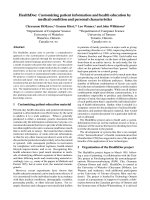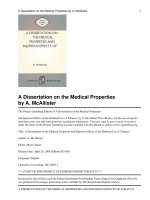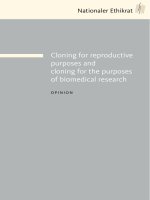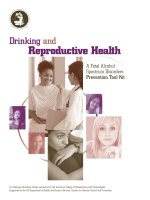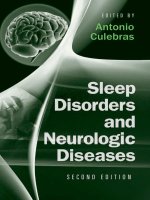MEDICAL PHYSICS AND BIOMEDICAL ENGINEERING potx
Bạn đang xem bản rút gọn của tài liệu. Xem và tải ngay bản đầy đủ của tài liệu tại đây (12.77 MB, 743 trang )
Medical Science Series
MEDICAL PHYSICS AND
BIOMEDICAL ENGINEERING
B H Brown, R H Smallwood, D C Barber,
P V Lawford and D R Hose
Department of Medical Physics and Clinical Engineering,
University of Sheffield and Central Sheffield University Hospitals,
Sheffield, UK
Institute of Physics Publishing
Bristol and Philadelphia
Copyright © 1999 IOP Publishing Ltd
© IOP Publishing Ltd 1999
All rights reserved. No part of this publication may be reproduced, stored in a retrieval system or transmitted
in any form or by any means, electronic, mechanical, photocopying, recording or otherwise, without the prior
permission of the publisher. Multiple copying is permitted in accordance with the terms of licences issued by
the Copyright Licensing Agency under the terms of its agreement with the Committee of Vice-Chancellors
and Principals.
Institute of Physics Publishing and the authors have made every possible attempt to find and contact the
original copyright holders for any illustrations adapted or reproduced in whole in the work. We apologize to
copyright holders if permission to publish in this book has not been obtained.
British Library Cataloguing-in-Publication Data
A catalogue record for this book is available from the British Library.
ISBN 0 7503 0367 0 (hbk)
ISBN 0 7503 0368 9 (pbk)
Library of Congress Cataloging-in-Publication Data are available
Consultant Editor:
J G Webster, University of Wisconsin-Madison, USA
Series Editors:
C G Orton, Karmanos Cancer Institute and Wayne State University, Detroit, USA
J A E Spaan, University of Amsterdam, The Netherlands
J G Webster, University of Wisconsin-Madison, USA
Published by Institute of Physics Publishing, wholly owned by The Institute of Physics, London
Institute of Physics Publishing, Dirac House, Temple Back, Bristol BS1 6BE, UK
US Office: Institute of Physics Publishing, The Public Ledger Building, Suite 1035, 150 South Independence
Mall West, Philadelphia, PA 19106, USA
Typeset in L
A
T
E
X using the IOP Bookmaker Macros
Printed in the UK by Bookcraft Ltd, Bath
Copyright © 1999 IOP Publishing Ltd
TheMedicalScienceSeriesistheofficialbookseriesoftheInternationalFederationforMedicaland
BiologicalEngineering(IFMBE)andtheInternationalOrganizationforMedicalPhysics(IOMP).
IFMBE
TheIFMBEwasestablishedin1959toprovidemedicalandbiologicalengineeringwithaninternational
presence.TheFederationhasalonghistoryofencouragingandpromotinginternationalcooperationand
collaborationintheuseoftechnologyforimprovingthehealthandlifequalityofman.
TheIFMBEisanorganizationthatismostlyanaffiliationofnationalsocieties.Transnationalorganiza-
tionscanalsoobtainmembership.Atpresentthereare42nationalmembers,andonetransnationalmember
withatotalmembershipinexcessof15000.Anobservercategoryisprovidedtogivepersonalstatusto
groupsororganizationsconsideringformalaffiliation.
Objectives
•Toreflecttheinterestsandinitiativesoftheaffiliatedorganizations.
•Togenerateanddisseminateinformationofinteresttothemedicalandbiologicalengineeringcommunity
andinternationalorganizations.
•Toprovideaninternationalforumfortheexchangeofideasandconcepts.
•Toencourageandfosterresearchandapplicationofmedicalandbiologicalengineeringknowledgeand
techniquesinsupportoflifequalityandcost-effectivehealthcare.
•Tostimulateinternationalcooperationandcollaborationonmedicalandbiologicalengineeringmatters.
•Toencourageeducationalprogrammeswhichdevelopscientificandtechnicalexpertiseinmedicaland
biologicalengineering.
Activities
TheIFMBEhaspublishedthejournalMedicalandBiologicalEngineeringandComputingforover34years.
AnewjournalCellularEngineeringwasestablishedin1996inordertostimulatethisemergingfieldin
biomedicalengineering.InIFMBENewsmembersarekeptinformedofthedevelopmentsintheFederation.
ClinicalEngineeringUpdateisapublicationofourdivisionofClinicalEngineering.TheFederationalso
hasadivisionforTechnologyAssessmentinHealthCare.
Everythreeyears,theIFMBEholdsaWorldCongressonMedicalPhysicsandBiomedicalEngineering,
organizedincooperationwiththeIOMPandtheIUPESM.Inaddition,annual,milestone,regionalconferences
areorganizedindifferentregionsoftheworld,suchastheAsiaPacific,Baltic,Mediterranean,Africanand
SouthAmericanregions.
TheadministrativecounciloftheIFMBEmeetsonceortwiceayearandisthesteeringbodyforthe
IFMBE.ThecouncilissubjecttotherulingsoftheGeneralAssemblywhichmeetseverythreeyears.
ForfurtherinformationontheactivitiesoftheIFMBE,pleasecontactJosAESpaan,ProfessorofMedical
Physics,AcademicMedicalCentre,UniversityofAmsterdam,POBox22660,Meibergdreef9,1105AZ,Am-
sterdam,TheNetherlands.Tel:31(0)205665200.Fax:31(0)206917233.E-mail:
WWW: />IOMP
The IOMP was founded in 1963. The membership includes 64 national societies, two international organiza-
tions and 12 000 individuals. Membership of IOMP consists of individual members of the Adhering National
Organizations. Two other forms of membership are available, namely Affiliated Regional Organization and
Corporate Members. The IOMP is administered by a Council, which consists of delegates from each of the
Adhering National Organization; regular meetings of Council are held every three years at the International
Copyright © 1999 IOP Publishing Ltd
Conference on Medical Physics (ICMP). The Officers of the Council are the President, the Vice-President and
the Secretary-General. IOMP committees include: developing countries, education and training; nominating;
and publications.
Objectives
•To organize international cooperation in medical physics in all its aspects, especially in developing countries.
• To encourage and advise on the formation of national organizations of medical physics in those countries
which lack such organizations.
Activities
Official publications of the IOMP are Physiological Measurement, Physics in Medicine and Biology and the
Medical Science Series, all published by Institute of Physics Publishing. The IOMP publishes a bulletin
Medical Physics World twice a year.
Two Council meetings and one General Assembly are held every three years at the ICMP. The most
recent ICMPs were held in Kyoto, Japan (1991), Rio de Janeiro, Brazil (1994) and Nice, France (1997). The
next conference is scheduled for Chicago, USA (2000). These conferences are normally held in collaboration
with the IFMBE to form the World Congress on Medical Physics and Biomedical Engineering. The IOMP
also sponsors occasional international conferences, workshops and courses.
For further information contact: Hans Svensson, PhD, DSc, Professor, Radiation Physics Department,
University Hospital, 90185 Umeå, Sweden. Tel: (46) 90 785 3891. Fax: (46) 90 785 1588. E-mail:
Copyright © 1999 IOP Publishing Ltd
CONTENTS
PREFACE
PREFACETO‘MEDICALPHYSICSANDPHYSIOLOGICALMEASUREMENT’
NOTESTOREADERS
ACKNOWLEDGMENTS
1BIOMECHANICS
1.1Introductionandobjectives
1.2Propertiesofmaterials
1.2.1Stress/strainrelationships:theconstitutiveequation
1.2.2Bone
1.2.3Tissue
1.2.4Viscoelasticity
1.3Theprinciplesofequilibrium
1.3.1Forces,momentsandcouples
1.3.2Equationsofstaticequilibrium
1.3.3Structuralidealizations
1.3.4Applicationsinbiomechanics
1.4Stressanalysis
1.4.1Tensionandcompression
1.4.2Bending
1.4.3Shearstressesandtorsion
1.5Structuralinstability
1.5.1Definitionofstructuralinstability
1.5.2Whereinstabilityoccurs
1.5.3Bucklingofcolumns:Eulertheory
1.5.4Compressivefailureofthelongbones
1.6Mechanicalworkandenergy
1.6.1Work,potentialenergy,kineticenergyandstrainenergy
1.6.2Applicationsoftheprincipleofconservationofenergy
1.7Kinematicsandkinetics
1.7.1Kinematicsoftheknee
1.7.2Walkingandrunning
1.8Dimensionalanalysis:thescalingprocessinbiomechanics
1.8.1Geometricsimilarityandanimalperformance
1.8.2Elasticsimilarity
1.9Problems
1.9.1Shortquestions
Copyright © 1999 IOP Publishing Ltd
1.9.2Longerquestions
2BIOFLUIDMECHANICS
2.1Introductionandobjectives
2.2Pressuresinthebody
2.2.1Pressureinthecardiovascularsystem
2.2.2Hydrostaticpressure
2.2.3Bladderpressure
2.2.4Respiratorypressures
2.2.5Footpressures
2.2.6Eyeandearpressures
2.3Propertiesoffluidsinmotion:theconstitutiveequations
2.3.1Newtonianfluid
2.3.2Otherviscositymodels
2.3.3Rheologyofblood
2.3.4Virchow’striad,haemolysisandthrombosis
2.4Fundamentalsoffluiddynamics
2.4.1Thegoverningequations
2.4.2Classificationofflows
2.5Flowofviscousfluidsintubes
2.5.1Steadylaminarflow
2.5.2Turbulentandpulsatileflows
2.5.3Branchingtubes
2.6Flowthroughanorifice
2.6.1Steadyflow:Bernoulli’sequationandthecontinuityequation
2.7Influenceofelasticwalls
2.7.1Windkesseltheory
2.7.2Propagationofthepressurepulse:theMoens–Kortewegequation
2.8Numericalmethodsinbiofluidmechanics
2.8.1Thedifferentialequations
2.8.2Discretizationoftheequations:finitedifferenceversusfiniteelement
2.9Problems
2.9.1Shortquestions
2.9.2Longerquestions
3PHYSICSOFTHESENSES
3.1Introductionandobjectives
3.2Cutaneoussensation
3.2.1Mechanoreceptors
3.2.2Thermoreceptors
3.2.3Nociceptors
3.3Thechemicalsenses
3.3.1Gustation(taste)
3.3.2Olfaction(smell)
3.4Audition
3.4.1Physicsofsound
3.4.2Normalsoundlevels
3.4.3Anatomyandphysiologyoftheear
3.4.4Theoriesofhearing
Copyright © 1999 IOP Publishing Ltd
3.4.5Measurementofhearing
3.5Vision
3.5.1Physicsoflight
3.5.2Anatomyandphysiologyoftheeye
3.5.3Intensityoflight
3.5.4Limitsofvision
3.5.5Colourvision
3.6Psychophysics
3.6.1WeberandFechnerlaws
3.6.2Powerlaw
3.7Problems
3.7.1Shortquestions
3.7.2Longerquestions
4BIOCOMPATIBILITYANDTISSUEDAMAGE
4.1Introductionandobjectives
4.1.1Basiccellstructure
4.2Biomaterialsandbiocompatibility
4.2.1Usesofbiomaterials
4.2.2Selectionofmaterials
4.2.3Typesofbiomaterialsandtheirproperties
4.3Materialresponsetothebiologicalenvironment
4.3.1Metals
4.3.2Polymersandceramics
4.4Tissueresponsetothebiomaterial
4.4.1Thelocaltissueresponse
4.4.2Immunologicaleffects
4.4.3Carcinogenicity
4.4.4Biomechanicalcompatibility
4.5Assessmentofbiocompatibility
4.5.1Invitromodels
4.5.2Invivomodelsandclinicaltrials
4.6Problems
4.6.1Shortquestions
4.6.2Longerquestions
5IONIZINGRADIATION:DOSEANDEXPOSURE—MEASUREMENTS,STANDARDSAND
PROTECTION
5.1Introductionandobjectives
5.2Absorption,scatteringandattenuationofgamma-rays
5.2.1Photoelectricabsorption
5.2.2Comptoneffect
5.2.3Pairproduction
5.2.4Energyspectra
5.2.5Inversesquarelawattenuation
5.3Biologicaleffectsandprotectionfromthem
Copyright © 1999 IOP Publishing Ltd
5.4Doseandexposuremeasurement
5.4.1Absorbeddose
5.4.2Doseequivalent
5.5Maximumpermissiblelevels
5.5.1Environmentaldose
5.5.2Whole-bodydose
5.5.3Organdose
5.6Measurementmethods
5.6.1Ionizationchambers
5.6.2G-Mcounters
5.6.3Scintillationcounters
5.6.4Filmdosimeters
5.6.5Thermoluminescentdosimetry(TLD)
5.7Practicalexperiment
5.7.1Dosemeasurementduringradiography
5.8Problems
5.8.1Shortquestions
5.8.2Longerquestions
6RADIOISOTOPESANDNUCLEARMEDICINE
6.1Introductionandobjectives
6.1.1Diagnosiswithradioisotopes
6.2Atomicstructure
6.2.1Isotopes
6.2.2Half-life
6.2.3Nuclearradiations
6.2.4Energyofnuclearradiations
6.3Productionofisotopes
6.3.1Naturallyoccurringradioactivity
6.3.2Man-madebackgroundradiation
6.3.3Inducedbackgroundradiation
6.3.4Neutronreactionsandman-maderadioisotopes
6.3.5Unitsofactivity
6.3.6Isotopegenerators
6.4Principlesofmeasurement
6.4.1Countingstatistics
6.4.2Samplecounting
6.4.3Liquidscintillationcounting
6.5Non-imaginginvestigation:principles
6.5.1Volumemeasurements:thedilutionprinciple
6.5.2Clearancemeasurements
6.5.3Surfacecounting
6.5.4Whole-bodycounting
6.6Non-imagingexamples
6.6.1Haematologicalmeasurements
6.6.2Glomerularfiltrationrate
6.7Radionuclideimaging
6.7.1Boneimaging
Copyright © 1999 IOP Publishing Ltd
6.7.2Dynamicrenalfunction
6.7.3Myocardialperfusion
6.7.4Qualityassuranceforgammacameras
6.8Tableofapplications
6.9Problems
6.9.1Shortproblems
6.9.2Longerproblems
7ULTRASOUND
7.1Introductionandobjectives
7.2Wavefundamentals
7.3Generationofultrasound
7.3.1Radiationfromaplanecircularpiston
7.3.2Ultrasoundtransducers
7.4Interactionofultrasoundwithmaterials
7.4.1Reflectionandrefraction
7.4.2Absorptionandscattering
7.5Problems
7.5.1Shortquestions
7.5.2Longerquestions
8NON-IONIZINGELECTROMAGNETICRADIATION:TISSUEABSORPTIONANDSAFETY
ISSUES
8.1Introductionandobjectives
8.2Tissueasaleakydielectric
8.3Relaxationprocesses
8.3.1Debyemodel
8.3.2Cole–Colemodel
8.4Overviewofnon-ionizingradiationeffects
8.5Low-frequencyeffects:0.1Hz–100kHz
8.5.1Propertiesoftissue
8.5.2Neuraleffects
8.5.3Cardiacstimulation:fibrillation
8.6Higherfrequencies:>100kHz
8.6.1Surgicaldiathermy/electrosurgery
8.6.2Heatingeffects
8.7Ultraviolet
8.8Electromedicalequipmentsafetystandards
8.8.1Physiologicaleffectsofelectricity
8.8.2Leakagecurrent
8.8.3Classificationofequipment
8.8.4Acceptanceandroutinetestingofequipment
8.9Practicalexperiments
8.9.1Themeasurementofearthleakagecurrent
8.9.2Measurementoftissueanisotropy
8.10Problems
8.10.1Shortquestions
8.10.2Longerquestions
Copyright © 1999 IOP Publishing Ltd
9GAININGACCESSTOPHYSIOLOGICALSIGNALS
9.1Introductionandobjectives
9.2Electrodes
9.2.1Contactandpolarizationpotentials
9.2.2Electrodeequivalentcircuits
9.2.3Typesofelectrode
9.2.4Artefactsandfloatingelectrodes
9.2.5Referenceelectrodes
9.3Thermalnoiseandamplifiers
9.3.1Electricpotentialspresentwithinthebody
9.3.2Johnsonnoise
9.3.3Bioelectricamplifiers
9.4Biomagnetism
9.4.1Magneticfieldsproducedbycurrentflow
9.4.2Magnetocardiogram(MCG)signals
9.4.3Coildetectors
9.4.4Interferenceandgradiometers
9.4.5Othermagnetometers
9.5Transducers
9.5.1Temperaturetransducers
9.5.2Displacementtransducers
9.5.3Gas-sensitiveprobes
9.5.4pHelectrodes
9.6Problems
9.6.1Shortquestions
9.6.2Longerquestionsandassignments
10EVOKEDRESPONSES
10.1Testingsystemsbyevokingaresponse
10.1.1Testingalinearsystem
10.2Stimuli
10.2.1Nervestimulation
10.2.2Currentsandvoltages
10.2.3Auditoryandvisualstimuli
10.3Detectionofsmallsignals
10.3.1Bandwidthandsignal-to-noiseratios
10.3.2Choiceofamplifiers
10.3.3Differentialamplifiers
10.3.4Principleofaveraging
10.4Electricalinterference
10.4.1Electricfields
10.4.2Magneticfields
10.4.3Radio-frequencyfields
10.4.4Acceptablelevelsofinterference
10.4.5Screeningandinterferencereduction
10.5Applicationsandsignalinterpretation
10.5.1Nerveactionpotentials
10.5.2EEGevokedresponses
Copyright © 1999 IOP Publishing Ltd
10.5.3Measurementofsignal-to-noiseratio
10.5.4Objectiveinterpretation
10.6Problems
10.6.1Shortquestions
10.6.2Longerquestions
11IMAGEFORMATION
11.1Introductionandobjectives
11.2Basicimagingtheory
11.2.1Three-dimensionalimaging
11.2.2Linearsystems
11.3Theimagingequation
11.3.1Thepointspreadfunction
11.3.2PropertiesofthePSF
11.3.3Pointsensitivity
11.3.4Spatiallinearity
11.4Positionindependence
11.4.1Resolution
11.4.2Sensitivity
11.4.3Multi-stageimaging
11.4.4Imagemagnification
11.5Reductionfromthreetotwodimensions
11.6Noise
11.7TheFouriertransformandtheconvolutionintegral
11.7.1TheFouriertransform
11.7.2Theshiftingproperty
11.7.3TheFouriertransformoftwosimplefunctions
11.7.4Theconvolutionequation
11.7.5Imagerestoration
11.8Imagereconstructionfromprofiles
11.8.1Back-projection:theRadontransform
11.9Samplingtheory
11.9.1Samplingonagrid
11.9.2Interpolatingtheimage
11.9.3Calculatingthesamplingdistance
11.10Problems
11.10.1Shortquestions
11.10.2Longerquestions
12IMAGEPRODUCTION
12.1Introductionandobjectives
12.2Radionuclideimaging
12.2.1Thegammacamera
12.2.2Energydiscrimination
12.2.3Collimation
12.2.4Imagedisplay
12.2.5Single-photonemissiontomography(SPET)
12.2.6Positronemissiontomography(PET)
Copyright © 1999 IOP Publishing Ltd
12.3Ultrasonicimaging
12.3.1Pulse–echotechniques
12.3.2Ultrasoundgeneration
12.3.3Tissueinteractionwithultrasound
12.3.4Transducerarrays
12.3.5Applications
12.3.6Dopplerimaging
12.4Magneticresonanceimaging
12.4.1Thenuclearmagneticmoment
12.4.2Precessioninthepresenceofamagneticfield
12.4.3T
1
andT
2
relaxations
12.4.4Thesaturationrecoverypulsesequence
12.4.5Thespin–echopulsesequence
12.4.6Localization:gradientsandsliceselection
12.4.7Frequencyandphaseencoding
12.4.8TheFIDandresolution
12.4.9Imagingandmultipleslicing
12.5CTimaging
12.5.1Absorptionofx-rays
12.5.2Datacollection
12.5.3Imagereconstruction
12.5.4Beamhardening
12.5.5SpiralCT
12.6Electricalimpedancetomography(EIT)
12.6.1IntroductionandOhm’slaw
12.6.2Imagereconstruction
12.6.3Datacollection
12.6.4Multi-frequencyand3Dimaging
12.7Problems
12.7.1Shortquestions
12.7.2Longerquestions
13MATHEMATICALANDSTATISTICALTECHNIQUES
13.1Introductionandobjectives
13.1.1Signalclassification
13.1.2Signaldescription
13.2Usefulpreliminaries:somepropertiesoftrigonometricfunctions
13.2.1Sinusoidalwaveform:frequency,amplitudeandphase
13.2.2Orthogonalityofsines,cosinesandtheirharmonics
13.2.3Complex(exponential)formoftrigonometricfunctions
13.3Representationofdeterministicsignals
13.3.1Curvefitting
13.3.2PeriodicsignalsandtheFourierseries
13.3.3Aperiodicfunctions,theFourierintegralandtheFouriertransform
13.3.4Statisticaldescriptorsofsignals
13.3.5Powerspectraldensity
13.3.6Autocorrelationfunction
Copyright © 1999 IOP Publishing Ltd
13.4Discreteorsampleddata
13.4.1Functionaldescription
13.4.2ThedeltafunctionanditsFouriertransform
13.4.3DiscreteFouriertransformofanaperiodicsignal
13.4.4Theeffectofafinite-samplingtime
13.4.5Statisticalmeasuresofadiscretesignal
13.5Appliedstatistics
13.5.1Datapatternsandfrequencydistributions
13.5.2Datadispersion:standarddeviation
13.5.3Probabilityanddistributions
13.5.4Sourcesofvariation
13.5.5Relationshipsbetweenvariables
13.5.6Propertiesofpopulationstatisticestimators
13.5.7Confidenceintervals
13.5.8Non-parametricstatistics
13.6Linearsignalprocessing
13.6.1Characteristicsoftheprocessor:responsetotheunitimpulse
13.6.2Outputfromageneralsignal:theconvolutionintegral
13.6.3Signalprocessinginthefrequencydomain:theconvolutiontheorem
13.7Problems
13.7.1Shortquestions
13.7.2Longerquestions
14IMAGEPROCESSINGANDANALYSIS
14.1Introductionandobjectives
14.2Digitalimages
14.2.1Imagestorage
14.2.2Imagesize
14.3Imagedisplay
14.3.1Displaymappings
14.3.2Lookuptables
14.3.3Optimalimagemappings
14.3.4Histogramequalization
14.4Imageprocessing
14.4.1Imagesmoothing
14.4.2Imagerestoration
14.4.3Imageenhancement
14.5Imageanalysis
14.5.1Imagesegmentation
14.5.2Intensitysegmentation
14.5.3Edgedetection
14.5.4Regiongrowing
14.5.5Calculationofobjectintensityandthepartialvolumeeffect
14.5.6Regionsofinterestanddynamicstudies
14.5.7Factoranalysis
14.6Imageregistration
Copyright © 1999 IOP Publishing Ltd
14.7Problems
14.7.1Shortquestions
14.7.2Longerquestions
15AUDIOLOGY
15.1Introductionandobjectives
15.2Hearingfunctionandsoundproperties
15.2.1Anatomy
15.2.2Soundwaves
15.2.3Basicproperties:dBscales
15.2.4Basicproperties:transmissionofsound
15.2.5Soundpressurelevelmeasurement
15.2.6Normalsoundlevels
15.3Basicmeasurementsofearfunction
15.3.1Pure-toneaudiometry:airconduction
15.3.2Pure-toneaudiometry:boneconduction
15.3.3Masking
15.3.4Accuracyofmeasurement
15.3.5Middle-earimpedanceaudiometry:tympanometry
15.3.6Measurementofoto-acousticemissions
15.4Hearingdefects
15.4.1Changeswithage
15.4.2Conductiveloss
15.4.3Sensoryneuralloss
15.5Evokedresponses:electricresponseaudiometry
15.5.1Slowvertexcorticalresponse
15.5.2Auditorybrainstemresponse
15.5.3Myogenicresponse
15.5.4Trans-tympanicelectrocochleography
15.6Hearingaids
15.6.1Microphonesandreceivers
15.6.2Electronicsandsignalprocessing
15.6.3Typesofaids
15.6.4Cochlearimplants
15.6.5Sensorysubstitutionaids
15.7Practicalexperiment
15.7.1Pure-toneaudiometryusedtoshowtemporaryhearingthresholdshifts
15.8Problems
15.8.1Shortquestions
15.8.2Longerquestions
16ELECTROPHYSIOLOGY
16.1Introductionandobjectives:sourcesofbiologicalpotentials
16.1.1Thenervoussystem
16.1.2Neuralcommunication
16.1.3Theinterfacebetweenionicconductors:Nernstequation
16.1.4Membranesandnerveconduction
16.1.5Muscleactionpotentials
16.1.6Volumeconductoreffects
Copyright © 1999 IOP Publishing Ltd
16.2TheECG/EKGanditsdetectionandanalysis
16.2.1CharacteristicsoftheECG/EKG
16.2.2Theelectrocardiographicplanes
16.2.3RecordingtheECG/EKG
16.2.4AmbulatoryECG/EKGmonitoring
16.3Electroencephalographic(EEG)signals
16.3.1Signalsizesandelectrodes
16.3.2Equipmentandnormalsettings
16.3.3NormalEEGsignals
16.4Electromyographic(EMG)signals
16.4.1Signalsizesandelectrodes
16.4.2EMGequipment
16.4.3Normalandabnormalsignals
16.5Neuralstimulation
16.5.1Nerveconductionmeasurement
16.6Problems
16.6.1Shortquestions
16.6.2Longerquestions
17RESPIRATORYFUNCTION
17.1Introductionandobjectives
17.2Respiratoryphysiology
17.3Lungcapacityandventilation
17.3.1Terminology
17.4Measurementofgasflowandvolume
17.4.1Thespirometerandpneumotachograph
17.4.2Bodyplethysmography
17.4.3Rotametersandpeak-flowmeters
17.4.4Residualvolumemeasurementbydilution
17.4.5Flowvolumecurves
17.4.6Transferfactoranalysis
17.5Respiratorymonitoring
17.5.1Pulseoximetry
17.5.2Impedancepneumography
17.5.3Movementdetectors
17.5.4Normalbreathingpatterns
17.6Problemsandexercises
17.6.1Shortquestions
17.6.2Reportingrespiratoryfunctiontests
17.6.3Useofpeak-flowmeter
17.6.4Pulseoximeter
18PRESSUREMEASUREMENT
18.1Introductionandobjectives
18.2Pressure
18.2.1Physiologicalpressures
18.3Non-invasivemeasurement
18.3.1Measurementofintraocularpressure
18.4Invasivemeasurement:pressuretransducers
Copyright © 1999 IOP Publishing Ltd
18.5Dynamicperformanceoftransducer–cathetersystem
18.5.1Kineticenergyerror
18.6Problems
18.6.1Shortquestions
18.6.2Longerquestions
19BLOODFLOWMEASUREMENT
19.1Introductionandobjectives
19.2Indicatordilutiontechniques
19.2.1Bolusinjection
19.2.2Constantrateinjection
19.2.3Errorsindilutiontechniques
19.2.4Cardiacoutputmeasurement
19.3Indicatortransporttechniques
19.3.1Selectiveindicators
19.3.2Inertindicators
19.3.3Isotopetechniquesforbrainbloodflow
19.3.4Localclearancemethods
19.4Thermaltechniques
19.4.1Thin-filmflowmeters
19.4.2Thermistorflowmeters
19.4.3Thermaldilution
19.4.4Thermalconductivitymethods
19.4.5Thermography
19.5Electromagneticflowmeters
19.6Plethysmography
19.6.1Venousocclusionplethysmography
19.6.2Straingaugeandimpedanceplethysmographs
19.6.3Lightplethysmography
19.7Bloodvelocitymeasurementusingultrasound
19.7.1TheDopplereffect
19.7.2DemodulationoftheDopplersignal
19.7.3Directionaldemodulationtechniques
19.7.4Filteringandtimedomainprocessing
19.7.5Phasedomainprocessing
19.7.6Frequencydomainprocessing
19.7.7FFTdemodulationandbloodvelocityspectra
19.7.8PulsedDopplersystems
19.7.9Clinicalapplications
19.8Problems
19.8.1Shortquestions
19.8.2Longerquestions
20BIOMECHANICALMEASUREMENTS
20.1Introductionandobjectives
20.2Staticmeasurements
20.2.1Loadcells
20.2.2Straingauges
20.2.3Pedobarograph
Copyright © 1999 IOP Publishing Ltd
20.3Dynamicmeasurements
20.3.1Measurementofvelocityandacceleration
20.3.2Gait
20.3.3Measurementoflimbposition
20.4Problems
20.4.1Shortquestions
20.4.2Longerquestions
21IONIZINGRADIATION:RADIOTHERAPY
21.1Radiotherapy:introductionandobjectives
21.2Thegenerationofionizingradiation:treatmentmachines
21.2.1Theproductionofx-rays
21.2.2Thelinearaccelerator
21.2.3Tele-isotopeunits
21.2.4Multi-sourceunits
21.2.5Beamcollimators
21.2.6Treatmentrooms
21.3Dosemeasurementandqualityassurance
21.3.1Dose-ratemonitoring
21.3.2Isodosemeasurement
21.4Treatmentplanningandsimulation
21.4.1Linearacceleratorplanning
21.4.2Conformaltechniques
21.4.3Simulation
21.5Positioningthepatient
21.5.1Patientshells
21.5.2Beamdirectiondevices
21.6Theuseofsealedradiationsources
21.6.1Radiationdosefromlinesources
21.6.2Dosimetry
21.6.3Handlingandstoringsealedsources
21.7Practical
21.7.1Absorptionofgammaradiation
21.8Problems
21.8.1Shortquestions
21.8.2Longerquestions
22SAFETY-CRITICALSYSTEMSANDENGINEERINGDESIGN:CARDIACAND
BLOOD-RELATEDDEVICES
22.1Introductionandobjectives
22.2Cardiacelectricalsystems
22.2.1Cardiacpacemakers
22.2.2Electromagneticcompatibility
22.2.3Defibrillators
22.3Mechanicalandelectromechanicalsystems
22.3.1Artificialheartvalves
22.3.2Cardiopulmonarybypass
22.3.3Haemodialysis,bloodpurificationsystems
22.3.4Practicalexperiments
Copyright © 1999 IOP Publishing Ltd
22.4Designexamples
22.4.1Safety-criticalaspectsofanimplantedinsulinpump
22.4.2Safety-criticalaspectsofhaemodialysis
22.5Problems
22.5.1Shortquestions
22.5.2Longerquestions
GENERALBIBLIOGRAPHY
Copyright © 1999 IOP Publishing Ltd
PREFACE
ThisbookisbaseduponMedicalPhysicsandPhysiologicalMeasurementwhichwewrotein1981.That
bookhadgrowninturnoutofabookletwhichhadbeenusedintheSheffieldDepartmentofMedicalPhysics
andClinicalEngineeringforthetrainingofourtechnicalstaff.Theintentionbehindourwritinghadbeen
togivepracticalinformationwhichwouldenablethereadertocarryoutaverywiderangeofphysiological
measurementandtreatmenttechniqueswhichareoftengroupedundertheumbrellatitlesofmedicalphysics,
clinicalengineeringandphysiologicalmeasurement.However,itwasmorefulfillingtotreatasubjectina
littledepthratherthanatapurelypracticallevelsoweincludedmuchofthebackgroundphysics,electronics,
anatomyandphysiologyrelevanttothevariousprocedures.Ourhopewasthatthebookwouldserveasan
introductorytexttograduatesinphysicsandengineeringaswellasservingtheneedsofourtechnicalstaff.
Whilstthisnewbookisbasedupontheearliertext,ithasamuchwiderintendedreadership.Wehave
stillincludedmuchofthepracticalinformationfortechnicalstaffbut,inaddition,aconsiderablygreaterdepth
ofmaterialisincludedforgraduatestudentsofbothmedicalphysicsandbiomedicalengineering.AtSheffield
weofferthismaterialinbothphysicsandengineeringcoursesatBachelor’sandMaster’sdegreelevels.Atthe
postgraduatelevelthetargetreaderisanewgraduateinphysicsorengineeringwhoisstartingpostgraduate
studiesintheapplicationofthesedisciplinestohealthcare.Thebookisintendedasabroadintroductory
textthatwillplacetheusesofphysicsandengineeringintheirmedical,socialandhistoricalcontext.Much
ofthetextisdescriptive,sothatthesepartsshouldbeaccessibletomedicalstudentswithaninterestinthe
technologicalaspectsofmedicine.Theapplicationsofphysicsandengineeringinmedicinehavecontinued
toexpandbothinnumberandcomplexitysince1981andwehavetriedtoincreaseourcoverageaccordingly.
Theexpansioninintendedreadershipandsubjectcoveragegaveusaproblemintermsofthesizeofthe
book.Asaresultwedecidedtoomitsomeoftheintroductorymaterialfromtheearlierbook.Wenolonger
includethebasicelectronics,andsomeoftheanatomyandphysiology,aswellasthebasicstatistics,have
beenremoved.Itseemedtousthattherearenowmanyothertextsavailabletostudentsintheseareas,sowe
havesimplyincludedtherelevantreferences.
Therangeoftopicswecoverisverywideandwecouldnothopetowritewithauthorityonallofthem.
Wehavepickedbrainsasrequired,butwehavealsoexpandedthenumberofauthorstofive.RodandIvery
muchthankRodHose,PatLawfordandDavidBarberwhohavejoinedusasco-authorsofthenewbook.
Wehavereceivedhelpfrommanypeople,manyofwhomwereacknowledgedintheprefacetothe
originalbook(seepagexxiii).NowaddedtothatlistareJohnConway,LisaWilliams,AdrianWilson,
ChristineSegasby,JohnFennerandTonyTrowbridge.Tonydiedin1997,buthewasasourceofinspiration
andwehaveusedsomeofhislecturematerialinChapter13.However,westartwitharecognitionofthe
encouragement given by Professor Martin Black. Our thanks must also go to all our colleagues who tolerated
our hours given to the book but lost to them. Sheffield has for many years enjoyed joint University and Hospital
activities in medical physics and biomedical engineering. The result of this is a large group of professionals
with a collective knowledge of the subject that is probably unique. We could not have written this book in a
narrow environment.
Copyright © 1999 IOP Publishing Ltd
We record our thanks to Kathryn Cantley at Institute of Physics Publishing for her long-term persistence
and enthusiasm. We must also thank our respective wives and husband for the endless hours lost to them. As
before, we place the initial blame at the feet of Professor Harold Miller who, during his years as Professor of
Medical Physics at Sheffield and in his retirement until his death in 1996, encouraged an enthusiasm for the
subject without which this book would never have been written.
Brian Brown and Rod Smallwood
Sheffield, 1998
Copyright © 1999 IOP Publishing Ltd
PREFACE TO ‘MEDICAL PHYSICS AND
PHYSIOLOGICAL MEASUREMENT’
This book grew from a booklet which is used in the Sheffield Department of Medical Physics and Clinical
Engineering for the training of our technical staff. The intention behind our writing has been to give practical
information which will enable the reader to carry out the very wide range of physiological measurement and
treatment techniques which are often grouped under the umbrella title of medical physics and physiological
measurement. However, it is more fulfilling to treat a subject in depth rather than at a purely practical level
and we have therefore included much of the background physics, electronics, anatomy and physiology which
is necessary for the student who wishes to know why a particular procedure is carried out. The book which
has resulted is large but we hope it will be useful to graduates in physics or engineering (as well as technicians)
who wish to be introduced to the application of their science to medicine. It may also be interesting to many
medical graduates.
There are very few hospitals or academic departments which cover all the subjects about which we have
written. In the United Kingdom, the Zuckermann Report of 1967 envisaged large departments of ‘physical
sciences applied to medicine’. However, largely because of the intractable personnel problems involved in
bringing together many established departments, this report has not been widely adopted, but many people
have accepted the arguments which advocate closer collaboration in scientific and training matters between
departments such as Medical Physics, Nuclear Medicine, Clinical Engineering, Audiology, ECG, Respiratory
Function and Neurophysiology. We are convinced that these topics have much in common and can benefit
from close association. This is one of the reasons for our enthusiasm to write this book. However, the coverage
is very wide so that a person with several years’ experience in one of the topics should not expect to learn
very much about their own topic in our book—hopefully, they should find the other topics interesting.
Much of the background introductory material is covered in the first seven chapters. The remaining
chapters cover the greater part of the sections to be found in most larger departments of Medical Physics
and Clinical Engineering and in associated hospital departments of Physiological Measurement. Practical
experiments are given at the end of most of the chapters to help both individual students and their supervisors. It
is our intention that a reader should follow the book in sequence, even if they omit some sections, but we accept
the reality that readers will take chapters in isolation and we have therefore made extensive cross-references
to associated material.
The range of topics is so wide that we could not hope to write with authority on all of them. We
considered using several authors but eventually decided to capitalize on our good fortune and utilize the wide
experience available to us in the Sheffield University and Area Health Authority (Teaching) Department of
Medical Physics and Clinical Engineering. We are both very much in debt to our colleagues, who have supplied
us with information and made helpful comments on our many drafts. Writing this book has been enjoyable to
both of us and we have learnt much whilst researching the chapters outside our personal competence. Having
said that, we nonetheless accept responsibility for the errors which must certainly still exist and we would
encourage our readers to let us know of any they find.
Copyright © 1999 IOP Publishing Ltd
Our acknowledgments must start with Professor M M Black who encouraged us to put pen to paper and
Miss Cecile Clarke, who has spent too many hours typing diligently and with good humour whilst looking
after a busy office. The following list is not comprehensive but contains those to whom we owe particular
debts: Harry Wood, David Barber, Susan Sherriff, Carl Morgan, Ian Blair, Vincent Sellars, Islwyn Pryce, John
Stevens, Walt O’Dowd, Neil Kenyon, Graham Harston, Keith Bomford, Alan Robinson, Trevor Jenkins, Chris
Franks, Jacques Hermans and Wendy Makin of our department, and also Dr John Jarratt of the Department
of Neurology and Miss Judith Connell of the Department of Communication. A list of the books which we
have used and from which we have profited greatly is given in the Bibliography. We also thank the Royal
Hallamshire Hospital and Northern General Hospital Departments of Medical Illustration for some of the
diagrams.
Finishing our acknowledgments is as easy as beginning them. We must thank our respective wives for
the endless hours lost to them whilst we wrote, but the initial blame we lay at the feet of Professor Harold
Miller who, during his years as Professor of Medical Physics in Sheffield until his retirement in 1975, and
indeed since that time, gave both of us the enthusiasm for our subject without which our lives would be much
less interesting.
Brian Brown and Rod Smallwood
Sheffield, 1981
Copyright © 1999 IOP Publishing Ltd
NOTESTOREADERS
Medicalphysicsandbiomedicalengineeringcoversaverywiderangeofsubjects,notallofwhichareincluded
inthisbook.However,wehaveattemptedtocoverthemainsubjectareassuchthatthematerialissuitable
forphysicalscienceandengineeringstudentsatbothgraduateandpostgraduatelevelswhohaveaninterest
infollowingacareereitherinhealthcareorinrelatedresearch.
Ourintentionhasbeentopresentboththescientificbasisandthepracticalapplicationofeachsubject
area.Forexample,Chapter3coversthephysicsofhearingandChapter15coversthepracticalapplication
ofthisinaudiology.ThebookthusfallsbroadlyintotwopartswiththebreakfollowingChapter14.Our
intentionhasbeenthatthematerialshouldbefollowedintheorderofthechaptersasthisgivesabroadview
ofthesubject.Inmanycasesonechapterbuildsupontechniquesthathavebeenintroducedinearlierchapters.
However,weappreciatethatstudentsmaywishtostudyselectedsubjectsandinthiscasewilljustreadthe
chapterscoveringtheintroductoryscienceandthentheapplicationofspecificsubjects.Cross-referencing
hasbeenusedtoshowwhereearliermaterialmaybeneededtounderstandaparticularsection.
Thepreviousbookwasintendedmainlyfortechnicalstaffandasabroadintroductorytextforgraduates.
However,wehavenowaddedmaterialatahigherlevel,appropriateforpostgraduatesandforthoseentering
aresearchprogrammeinmedicalphysicsandbiomedicalengineering.Somesectionsofthebookdoassume
adegreelevelbackgroundinthemathematicsneededinphysicsandengineering.Theintroductiontoeach
chapterdescribesthelevelofmaterialtobepresentedandreadersshouldusethisindecidingwhichsections
are appropriate to their own background.
As the book has been used as part of Sheffield University courses in medical physics and biomedical
engineering, we have included problems at the end of each chapter. The intention of the short questions is
that readers can test their understanding of the main principles of each chapter. Longer questions are also
given, but answers are only given to about half of them. Both the short and longer questions should be useful
to students as a means of testing their reading and to teachers involved in setting examinations.
The text is now aimed at providing the material for taught courses. Nonetheless we hope we have not
lost sight of our intention simply to describe a fascinating subject area to the reader.
Copyright © 1999 IOP Publishing Ltd
ACKNOWLEDGMENTS
We would like to thank the following for the use of their material in this book: the authors of all figures not
originated by ourselves, Butterworth–Heinemann Publishers, Chemical Rubber Company Press, Churchill
Livingstone, Cochlear Ltd, John Wiley & Sons, Inc., Macmillian Press, Marcel Dekker, Inc., Springer-Verlag
GmbH & Co. KG, The MIT Press.
Copyright © 1999 IOP Publishing Ltd
CHAPTER1
BIOMECHANICS
1.1.INTRODUCTIONANDOBJECTIVES
Inthischapterwewillinvestigatesomeofthebiomechanicalsystemsinthehumanbody.Weshallsee
howevenrelativelysimplemechanicalmodelscanbeusedtodevelopaninsightintotheperformanceofthe
system.Someofthequestionsthatweshalladdressarelistedbelow.
•Whatsortsofloadsaresupportedbythehumanbody?
•Howstrongareourbones?
•Whataretheengineeringcharacteristicsofourtissues?
•Howefficientisthedesignoftheskeleton,andwhatarethelimitsoftheloadsthatwecanapplytoit?
•Whatmodelscanweusetodescribetheprocessoflocomotion?Whatcanwedowiththesemodels?
•Whatarethelimitsontheperformanceofthebody?
•Whycanafrogjumpsohigh?
Thematerialinthischapterissuitableforundergraduates,graduatesandthemoregeneralreader.
1.2.PROPERTIESOFMATERIALS
1.2.1.Stress/strainrelationships:theconstitutiveequation
Ifwetakearodofsomematerialandsubjectittoaloadalongitsaxisweexpectthatitwillchangeinlength.
Wemightdrawaload/displacementcurvebasedonexperimentaldata,asshowninfigure1.1.
Wecouldconstructacurvelikethisforanyrod,butitisobviousthatitsshapedependsonthegeometry
oftherodasmuchasonanypropertiesofthematerialfromwhichitismade.Wecould,however,choptherod
upintosmallerelementsand,apartfromdifficultiesclosetotheends,wemightreasonablyassumethateach
elementofthesamedimensionscarriesthesameamountofloadandextendsbythesameamount.Wemight
thendescribethedisplacementintermsofextensionperunitlength,whichwewillcallstrain(ε),andthe
loadintermsofloadperunitarea,whichwewillcallstress(σ).Wecanthenredrawtheload/displacement
curveasastress/straincurve,andthisshouldbeindependentofthedimensionsofthebar.Inpracticewe
mighthavetotakesomecareinthedesignofatestspecimeninordertoeliminateendeffects.
Theshapeofthestress/straincurveillustratedinfigure1.2istypicalofmanyengineeringmaterials,
andparticularlyofmetalsandalloys.Inthecontextofbiomechanicsitisalsocharacteristicofbone,whichis
studiedinmoredetailinsection1.2.2.ThereisalinearportionbetweentheoriginOandthepointY.Inthis
Copyright © 1999 IOP Publishing Ltd
